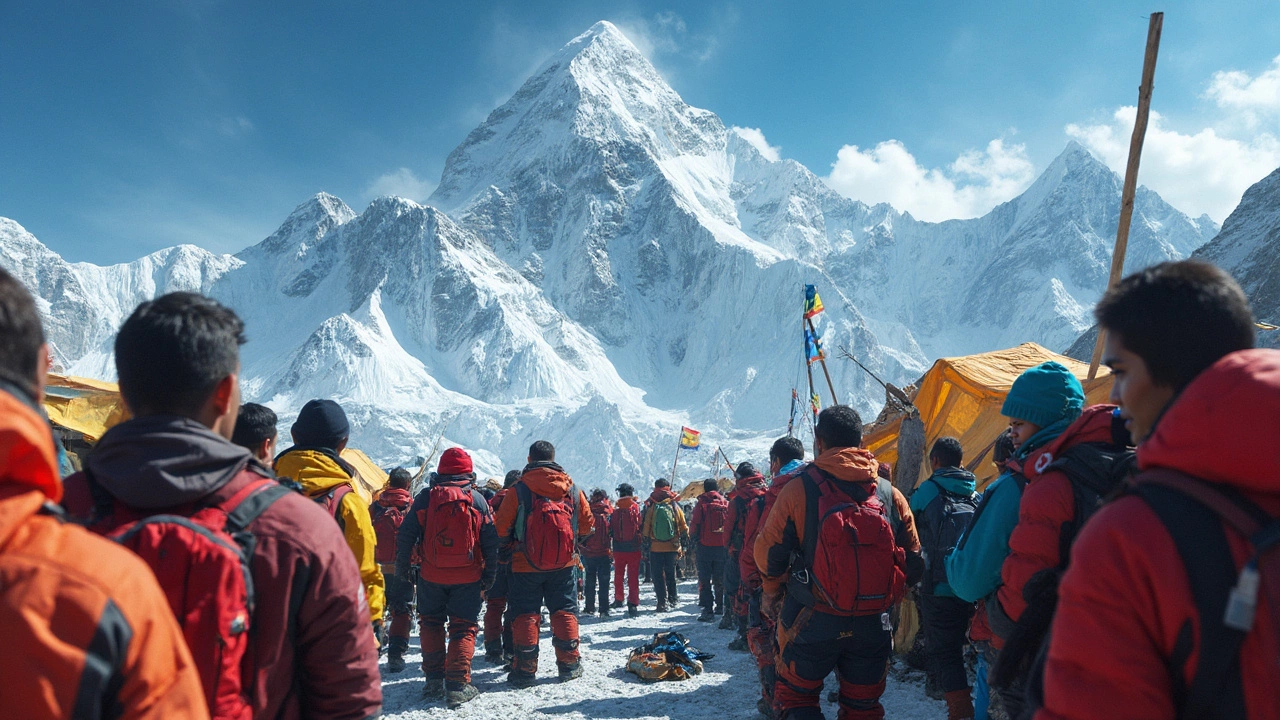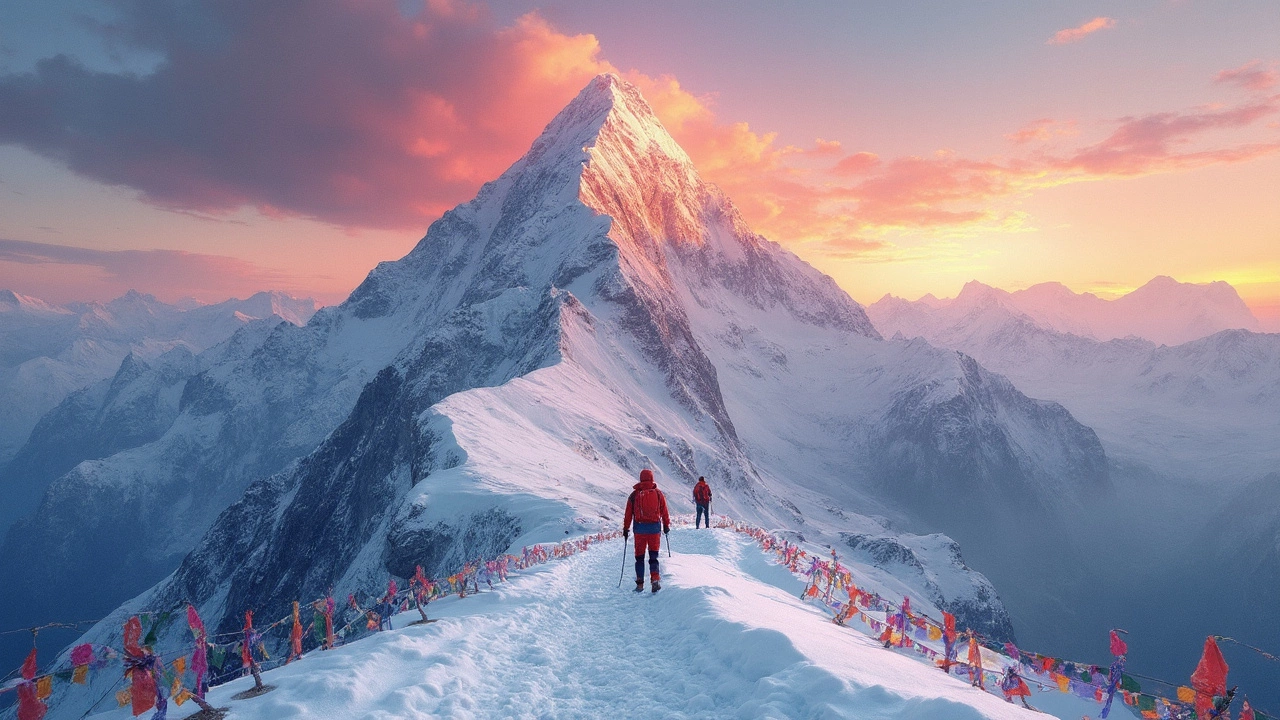Picture this: you're standing amidst the majestic Himalayas, contemplating the next big climb. Is it Kanchenjunga or Everest that’s calling your name? Both peaks offer formidable challenges, but there are some key differences worth noting. Let's dive into what makes Kanchenjunga potentially tougher than Everest.
Firstly, Kanchenjunga might not be as towering as Everest, but its remoteness is a factor that can't be ignored. Located in India with its summit crossing into Nepal, the journey just to the base camp can feel like an adventure of its own. The trails are less trodden, giving you a sense of isolation that's both thrilling and daunting. Plus, this means fewer amenities compared to the ever-popular Everest.
Another crucial aspect is the weather. While Everest has more stable climbing windows, Kanchenjunga's unpredictable weather can catch even seasoned climbers off-guard. The storms roll in with little warning, and snow conditions are often tricky. It’s as if the mountain is daring climbers to test their limits.
Technically, Kanchenjunga’s routes are tougher and require advanced skills. With steep ascents, treacherous crevasses, and the ever-present risk of avalanches, it not only challenges your physical endurance but also your climbing proficiency. If you’re up for the challenge, proper preparation and a solid team are your best allies.
Intrigued yet? These are just a few of the factors to consider when pondering a trek to these mighty summits. Whatever you choose, remember that every climb is a reflection of nature’s magnificent artistry and a test of your resilience.
Height and Location
When folks talk about the giants of the Himalayas, Everest is usually the first name thrown around. And it makes sense—it's the tallest mountain on the planet at a whopping 8,848 meters (29,029 feet). Located on the border between Nepal and the Tibet Autonomous Region of China, Everest has been the ultimate goal for climbers from every corner of the globe.
But, let’s not forget about Kanchenjunga. It may sit in the shadow of Everest’s fame, but it’s still the third highest peak in the world. At 8,586 meters (28,169 feet), it offers a different kind of challenge. Kanchenjunga straddles the border of Nepal and the Indian state of Sikkim. Its location is a crucial element of its allure—and difficulty.
Accessibility and Isolation
Getting to Everest Base Camp is a trekker's dream with relatively established routes, helpful Sherpa guides, and even tea houses along the way. In contrast, Kanchenjunga's paths offer a far more isolated experience. With fewer trekkers venturing there, you’re left with just you and the raw power of nature, something that both excites and intimidates.
For Kanchenjunga fans, it’s the trek TO the mountain that’s the first part of the adventure. The journey here takes you through remote villages and diverse terrains, making accessibility a significant factor in the mountain’s overall challenge.
For enthusiasts looking to compare Kanchenjunga to Everest, the table below gives a quick glance at some key differences:
| Feature | Everest | Kanchenjunga |
|---|---|---|
| Height | 8,848m | 8,586m |
| First Ascent | 1953 | 1955 |
| Main Climbing Season | April-May | April-May |
| Location | Nepal/Tibet | India/Nepal |
So what do you get when you step away from the beaten path? An opportunity to engage with raw nature and perhaps a quieter, more meditative journey. The height may be slightly less than Everest, but the isolation and rugged terrain push Kanchenjunga’s difficulty up a notch for many climbers, making it an intriguing choice for those ready to face the Himalayas head-on.
Weather and Climate
When comparing the weather and climate on Kanchenjunga with that on Everest, one of the major differences you’ll notice is the unpredictability. Kanchenjunga tends to have more erratic weather patterns, which can surprise climbers. This is partly due to its location and the unique climatic influences from the surroundings.
Temperatures and Conditions
On Kanchenjunga, temperatures can plummet dramatically. In the climbing season, expect temperatures to be as low as -25°C (-13°F) at higher altitudes. Couple that with strong winds, and you've got a chilling challenge ahead. Compare this with Everest, where, during peak seasons, the conditions are often slightly more predictable and generally better known due to extensive recorded data.
Rainfall and Snowfall
The monsoon can significantly affect both mountains, but in different ways. Kanchenjunga's proximity to the Bay of Bengal means it can experience heavier monsoonal impacts, including intense rainfall and snowfall. This results in slippery slopes and increased avalanche risks, making trekking tougher during these periods.
Climbing Windows
Climbing Kanchenjunga requires watching for small windows of opportunity. Typically, the best times to attempt a climb are pre-monsoon (April to May) and post-monsoon (late September to October). These periods offer the most stable weather, but plan carefully because the window can shut quickly, leaving you with little time to acclimate and summit safely.
| Month | Average Temperature (°C) | Weather Conditions |
|---|---|---|
| April | -15 | Cold, dry |
| May | -10 | Milder, unstable |
| September | -12 | Dry, stable |
| October | -15 | Cold, windy |
Understanding the weather and climate on Kanchenjunga is crucial for a safe and successful climb. Hiring experienced local guides who are familiar with these conditions can be invaluable. So, if you're planning to take on this beast of a mountain, pack for extremes and always have a flexible plan for rapidly changing weather.

Technical Challenges
If you're thinking about tackling Kanchenjunga, it's important to understand just what makes it a beast when it comes to climbing. Unlike Everest, Kanchenjunga offers fewer established trails, meaning climbers often face the daunting task of breaking new ground.
Steep Ascents and Descents
To get to the summit of Kanchenjunga, climbers deal with extremely steep sections, which require not just stamina but also expert technical skills. Ropes and ladders are often necessary to navigate these tricky parts safely.
Ever-Present Crevasses
Along the way, you'll encounter countless crevasses – some hidden, some apparent. These gaping glacial chasms can be perilous, demanding careful navigation and often teamwork. A rope team and thorough crevasse rescue skills are paramount out here.
Tough Weather Conditions
Weather-wise, climbing Kanchenjunga is a whole different ballgame. Rapid weather changes are frequent, ramping up the risk of avalanches and unstable snow. Predicting weather windows is tougher compared to Everest, and climbers often have to move fast or risk being stranded.
Lesser-Known Routes with Fewer Resources
The climb isn't just physically taxing; there's also the logistical aspect. On Everest, you're more likely to find established camps and resources. In contrast, Kanchenjunga's routes are less commercialized. This means fewer resources and guides, putting more responsibility on the climbers themselves for carrying supplies and building camps.
Ready to face the challenge? Make sure your technical skills are honed, and consider joining an experienced expedition team for a safer approach to conquering Kanchenjunga.
Trekking Routes and Accessibility
When evaluating the difficulties of climbing Kanchenjunga and Everest, one area that stands out is how you actually get there. Let’s take a closer look at the trekking routes and how accessible these majestic giants are.
Trekking to Kanchenjunga
The adventure to Kanchenjunga often starts in the quiet town of Yuksom in Sikkim, India. This journey is definitely for those looking for a more rustic experience. The paths are fewer in number and less maintained. Trekkers typically spend days traveling through remote villages and dense forests.
Accessibility is a significant factor here. The lack of infrastructure can make things tricky, but it's exactly this remoteness that draws seasoned adventurers. As renowned climber Joe Brown once said:
“The challenge of Kanchenjunga lies not just in its height or technical demands, but in the very journey itself.”
If you’re someone who enjoys stepping away from the crowds, this could be your perfect fit.
Trekking to Everest
Conversely, Everest is a bit of a social hub. With multiple well-established routes like the South Col and the famed Base Camp trek from Lukla, it offers variety in both scenery and experience. Thanks to a bustling trekking tourism industry, the trails are well-trodden and lined with teahouses where you can find a cuppa or a quick recharge.
If comfort and accessibility are important, the routes to Everest have the upper hand. Regular flights to Lukla, a constant flow of trekkers, and seasoned guides make organizing your trek easier. This doesn’t mean it’s a walk in the park, though—altitude and weather can throw unexpected challenges your way.
Which Route Is For You?
A simple comparison in accessibility:
| Mountain | Key Access Points | Average Trek Duration |
|---|---|---|
| Kanchenjunga | Yuksom, Sikkim | 20-30 days |
| Everest | Lukla, Nepal | 10-15 days |
Ultimately, choosing between Kanchenjunga and Everest often comes down to personal preference. Are you seeking an off-the-beaten-path adventure or a journey filled with camaraderie and established support?
No matter your choice, both routes will mesmerize you with their breathtaking landscapes.
